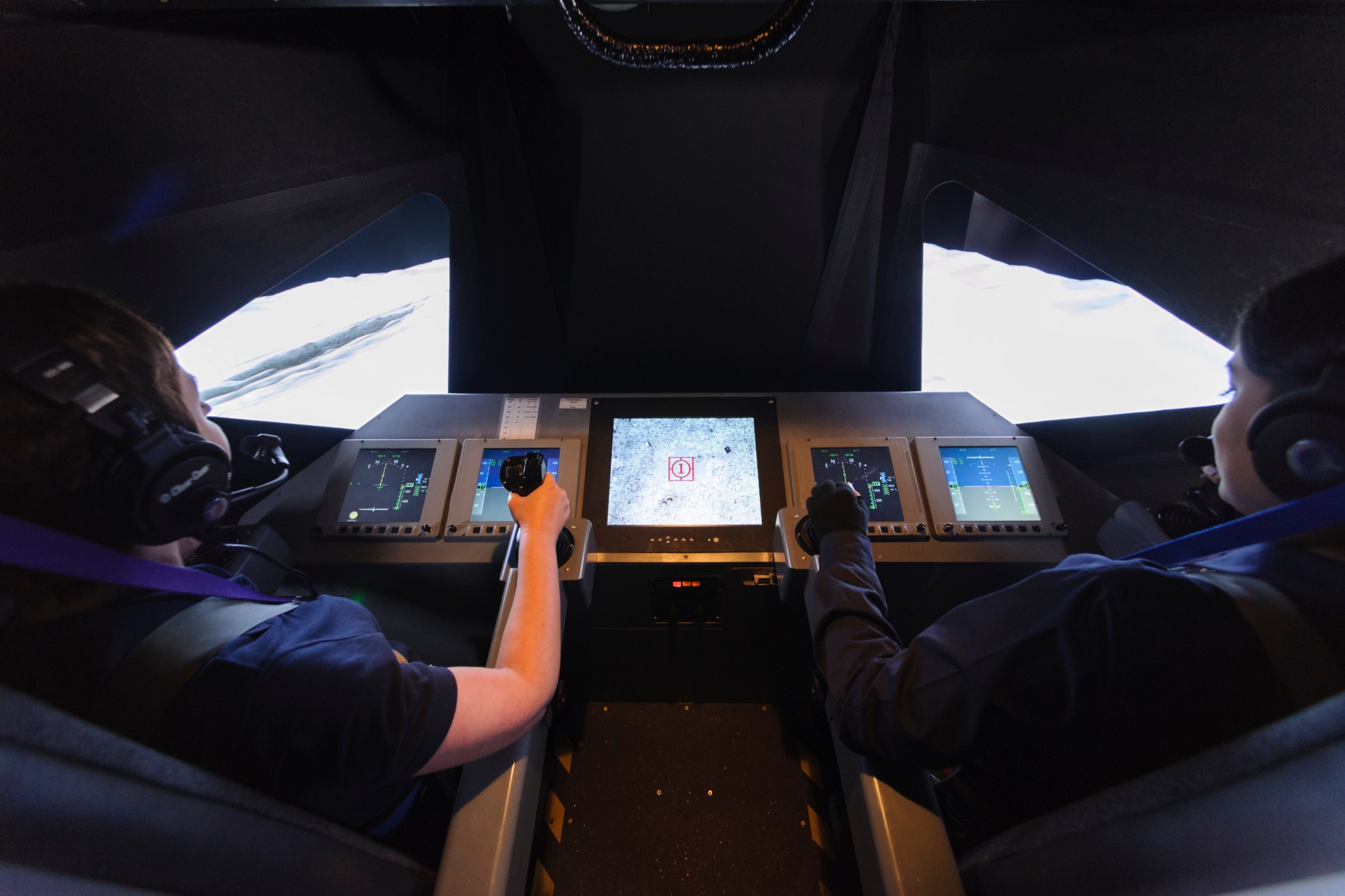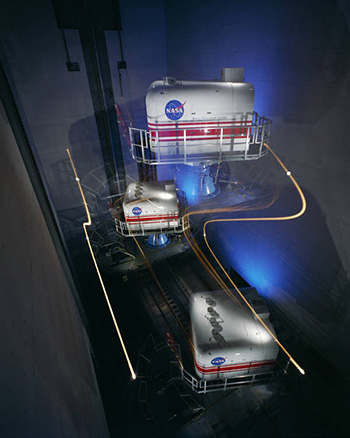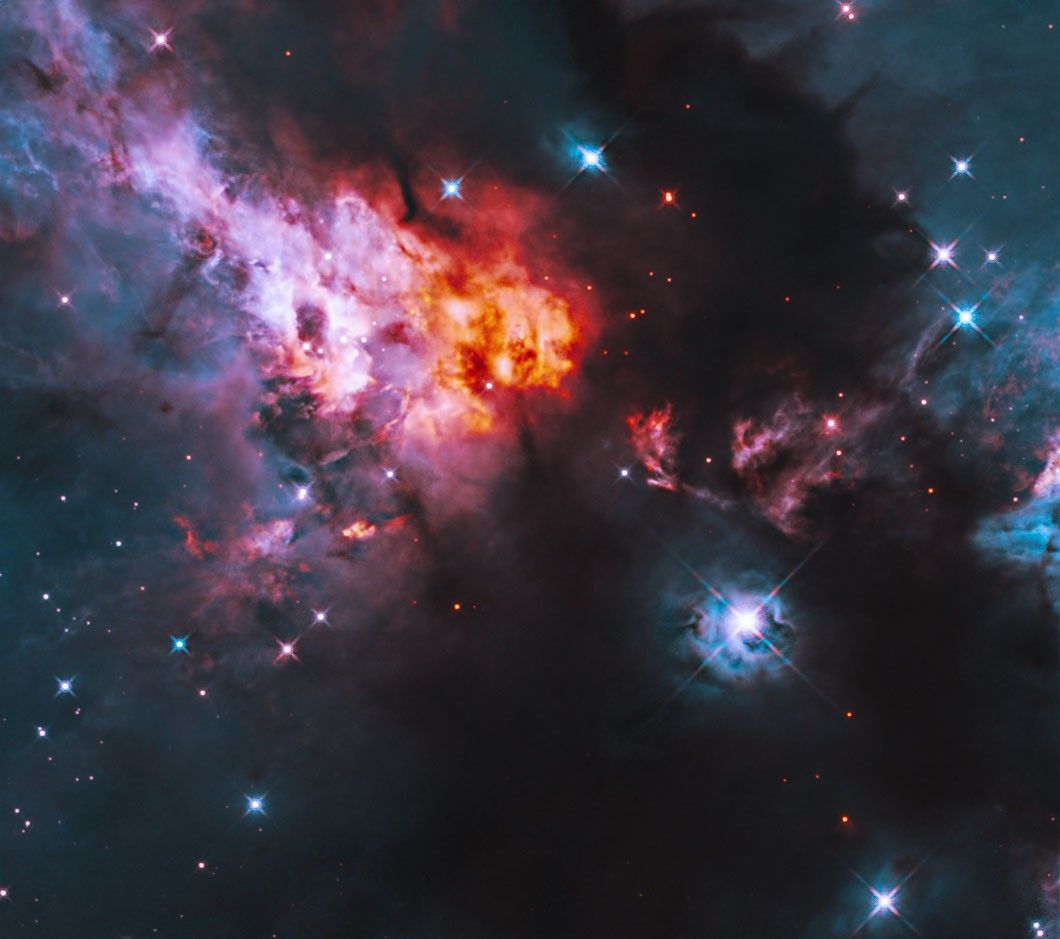The world’s largest flight simulator for high-fidelity testing of new and experimental aircraft and spacecraft designs
Driven by powerful motors and a system of hydraulics, NASA’s VMS (Vertical Motion Simulator) smoothly moves as much as 60 feet vertically and 40 feet horizontally within a 10-story tower at the agency’s Ames Research Center in California’s Silicon Valley.
The VMS offers an unequaled range of motion in all six degrees of freedom – the six ways that an aircraft or spacecraft moves. There are three translational degrees of freedom (forward/backward, up/down, and left/right) and three rotational degrees of freedom (roll right/left, pitch up/down, and yaw clockwise/counterclockwise). This range of motion allows the VMS to accurately simulate all phases of flight, including takeoff, cruise, and landing.
For a given simulation, the VMS motion platform uses one of five interchangeable cabs, which can be configured to recreate the cockpit of any aerospace vehicle – whether it exists today or is being designed for the future.
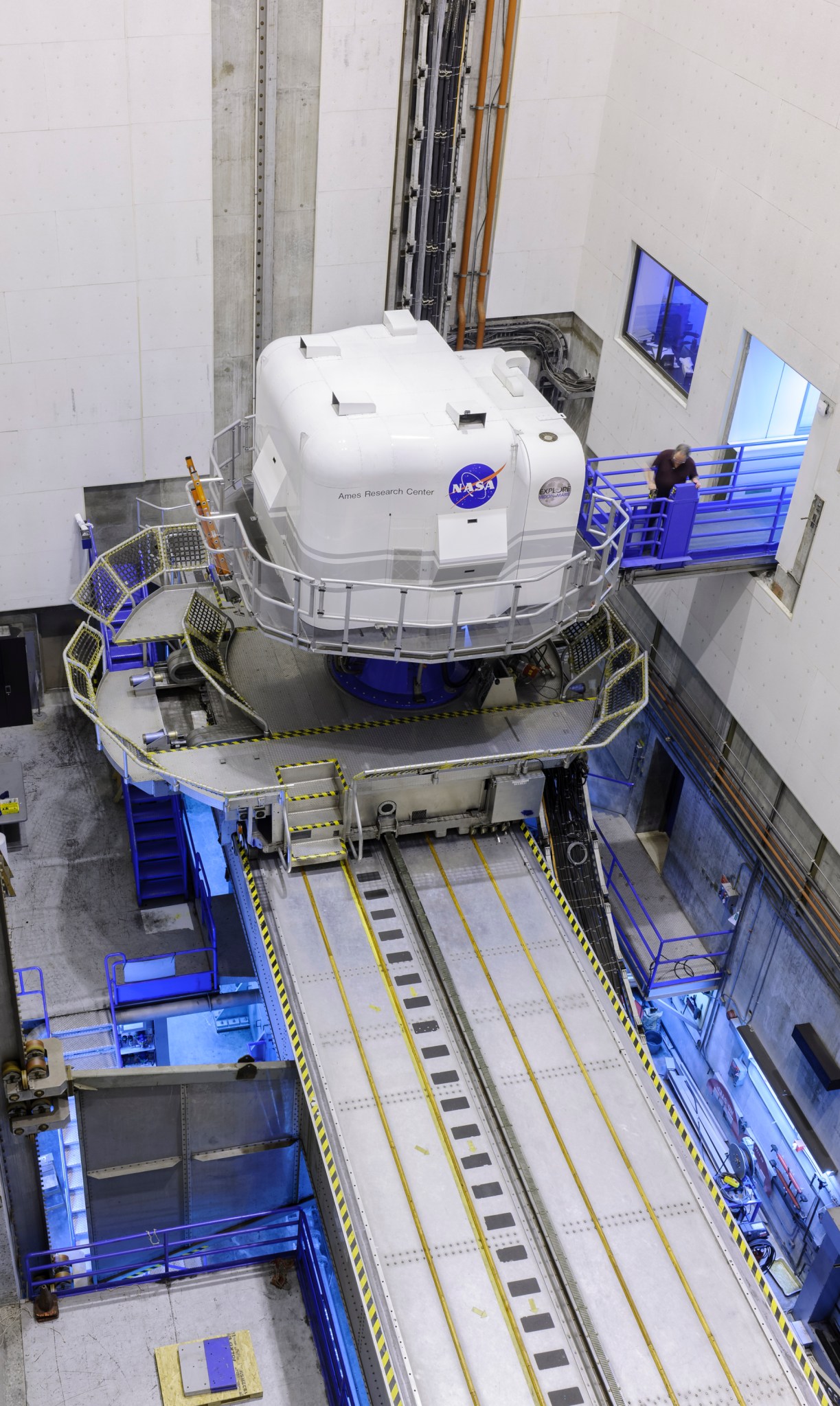
Designers and pilots of fighter jets, tilt-rotor aircraft, helicopters, the space shuttle, lunar lander, airships, and more have had the chance to test out their vehicles before taking to the skies.
A Life-Like Experience
The motion of the VMS is based on aircraft math models developed using real data from actual aircraft, wind tunnels, and computational fluid dynamic analysis. This lets the VMS generate precise accelerations that result in a near-flight-like experience for pilots and passengers. Simulators with no motion or limited motion are useful for some development and training, but for the highest fidelity experience before actual flight, the VMS is the best option.
The out-the-window graphics – the computer-generated images that simulate the outside world and provide visual cues for the pilot – are highly customizable. The VMS maintains many representations of locations in the United States and abroad. Three-dimensional models, such as aircraft, ground vehicles and buildings, are included in the graphics, as well as simulations of various weather and lighting conditions. All the scenes can be modified, and new ones are created according to project needs.
Flexibility for a Wide Variety of Vehicles
Researchers perform engineering studies at the VMS to evaluate the effectiveness of flight control systems, rapidly test changes to aircraft design, or evaluate different flight-control algorithms. Aerospace companies, government agencies, as well as other industries use the VMS for developing aircraft or transportation concepts, and then later for flight control design refinements and to evaluate handling qualities.
Flexibility in both hardware and software allows NASA’s VMS to simulate the flight of any aerospace vehicle. The flight controls, flight instruments and aircraft seats of each cab can be modified for different studies. Powerful computers and custom-designed systems enable the rapid development of high-fidelity, real-time simulation. This allows researchers to test handling qualities and tease out design problems and potential flaws before a vehicle is built, before it flies and, perhaps, before it lands on the Moon.
Air Taxis and Urban Transportation Concepts
Since the cabs are reconfigurable, all hardware and software can be customized for new projects. Over the decades, the VMS has simulated a wide variety of vehicles, from fixed-wing, rotorcraft, and vertical takeoff and landing aircraft, to newly designed and conceived experimental craft, such as NASA’s X-59 Quiet Supersonic Technology aircraft.
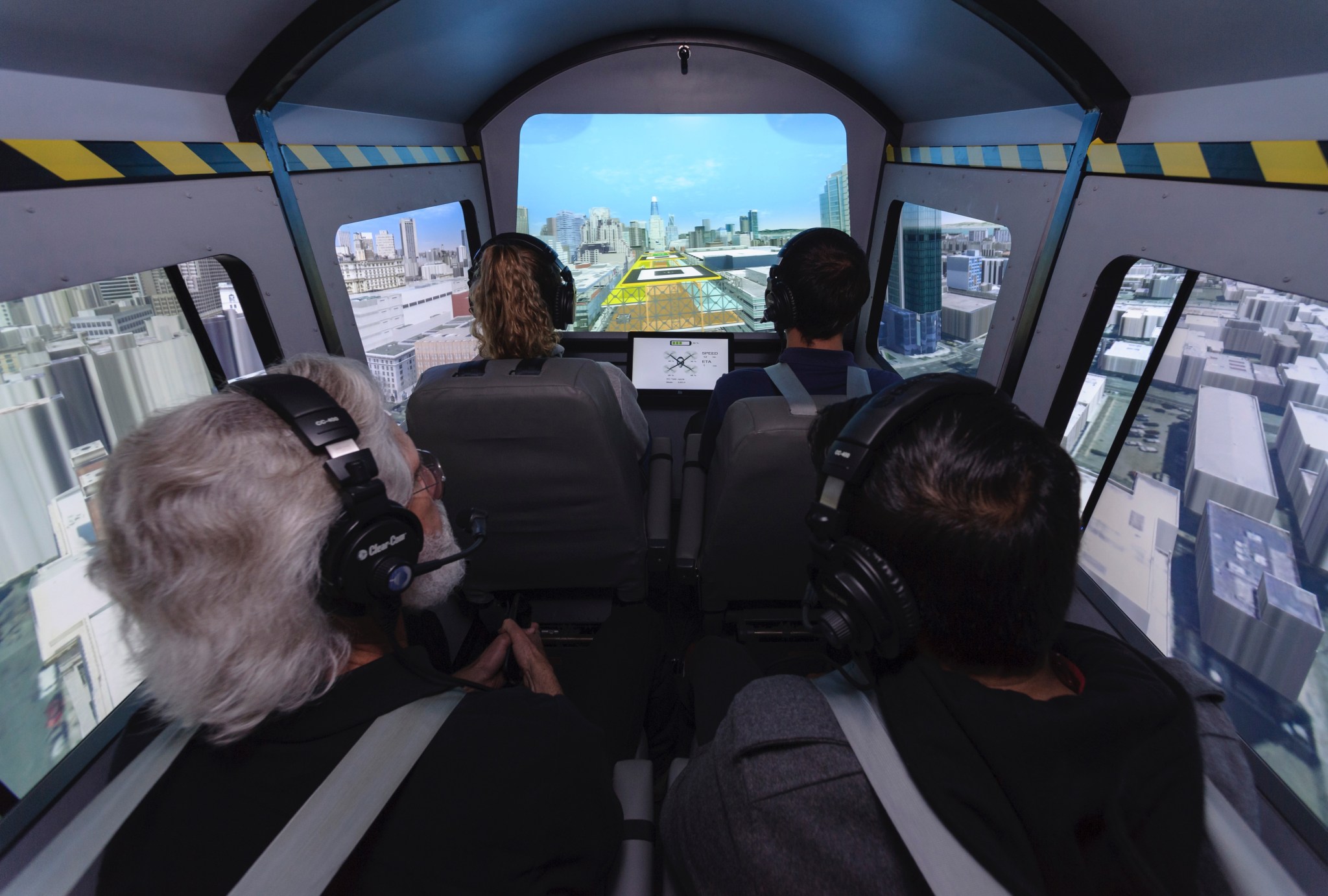
The VMS also supports research to create a safe and efficient air transportation system, which could involve passenger-carrying air taxis operating above populated areas, dubbed Advanced Air Mobility. VMS engineers and researchers are supporting aviation activities with the Federal Aviation Administration, or FAA, NASA’s National Campaign project, and the NASA Revolutionary Vertical Lift project by determining which automation tools can better help pilots, as well as studying ride and handling qualities.
Lunar Landers, from Design to Training
The VMS is primarily a research simulator, where designers can test out their ideas and optimize the performance of aircraft and spacecraft. The VMS was originally designed to support research in the development of new aircraft concepts here on Earth – but it was also used to model vehicle docking maneuvers with the International Space Station in near Earth orbit. It can even be a valuable training simulator, as was the case for the Space Shuttle Program. Every NASA shuttle pilot received training in the VMS, and future Moon-bound astronauts may as well.
With virtually no atmosphere and only one-sixth the gravity of Earth, the Moon will feel very different to a pilot behind the controls. As new lunar lander designs are developed, the VMS can perform testing and evaluation. The lunar lander cab features hand controllers that might be used in future lunar lander designs, and the simulator provides realistic visual and motion cues to the pilot. The VMS already has simulated two types of lunar flight – that of the Apollo Lunar Module and of the Altair, a lunar lander concept vehicle explored in the 2000s. More recently, NASA’s Human Landing System program partners analyzed and improved early lander concepts to deliver humans to the lunar surface as part of NASA’s Artemis missions.
The motion of the VMS in those six degrees of freedom is based on real data from research on aircraft handling. This lets the VMS generate precise accelerations that result in a near-flight-like experience for pilots. Simulators with no motion or only tilting motion are useful for some development and training, but for the highest fidelity experience before actual flight, the VMS is the best option.
The out-the-window graphics – the computer-generated images that simulate the outside world and provide visual cues for the pilot – are highly customizable. The VMS maintains many representations of geographic locations in the United States and abroad. Three-dimensional models, such as aircraft, ground vehicles and buildings, are included in the graphics, and various weather and light conditions can be simulated. All the scenes can be modified, and new ones are created according to project needs.
Learn more:
- NASA image feature: Air Taxi Ride Quality: Seeking a Smooth Ride at the Vertical Motion Simulator (Feb. 26, 2020)
- NASA video: NASA’s Vertical Motion Simulator (Sept. 27, 2019)
- NASA image feature: “Flying” a Lunar Lander, Right Here on Earth (June 3, 2019)
- NASA video: STS-135 Flight Crew Trains on VMS at NASA Ames (July 8, 2011)
- NASA video: VMS Pre History (Oct. 13, 2010)
- NASA video: VMS Shuttle Sim (Oct. 18, 2010)
Milestones:
- 2022: The VMS upgraded all video infrastructure from analog to digital to improve the quality of the simulator images.
- 2023: The VMS will upgrade the out-the-window display from segmented “windows” to one continuous dome display system. The dome system will be fixed to the motion system and the facility will transition to using interchangeable flight decks instead of the current interchangeable cabs.
For researchers:
· Ames Simulation Labs homepage
· Vertical Motion Simulator (VMS) Complex, at the Ames SimLabs
· Simulate Future Space at NASA Ames SimLabs
· Lunar Lander Handling Qualities Experiment at Ames’ Vertical Motion Simulator
· Vertical Motion Simulator (VMS) Technical Details
For news media:
To get in touch with someone from the Vertical Motion Simulator, please contact the NASA Ames newsroom.



























